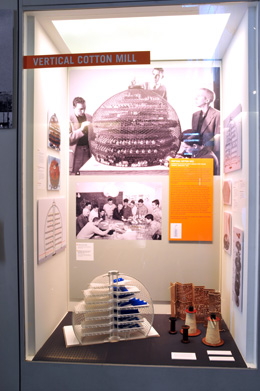The Skyscraper Museum is devoted to the study of high-rise building, past, present, and future. The Museum explores tall buildings as objects of design, products of technology, sites of construction, investments in real estate, and places of work and residence. This site will look better in a browser that supports web standards, but it is accessible to any browser or Internet device.
VERTICAL COTTON MILL
Buckminster Fuller and North Carolina State College students
unrealized, 1952

Buckminster Fuller, Automatic Cotton Mill, 1952, model designed with North Carolina State University students. Courtesy North Carolina State University, College of Design. Photograph by Ralph Mills.

Photograph � Christopher Hall
Buckminster Fuller, working with 20 graduate students from the architecture and textile schools of North Carolina State College at Raleigh, conceived the vertical cotton mill, also known as the "fountain factory"-- a spherical design based loosely on Fuller's Dymaxion House. Cotton would be suctioned upwards through the building and then processed downwards toward the ground floor. The central mast core was both functional and structural: it housed the elevator, utility lines, air ducts, and water supply, and suction tubes; it also suspended a triangulated, open truss-work floor with tensioned cables. The open trusses allowed goods to transfer between floors at multiple points. The shell of the geodesic sphere, was made of double-layered plastic skin for insulation and return air flow. Although Fuller's mill was never built, industrialists and the architecture community alike praised his design.
